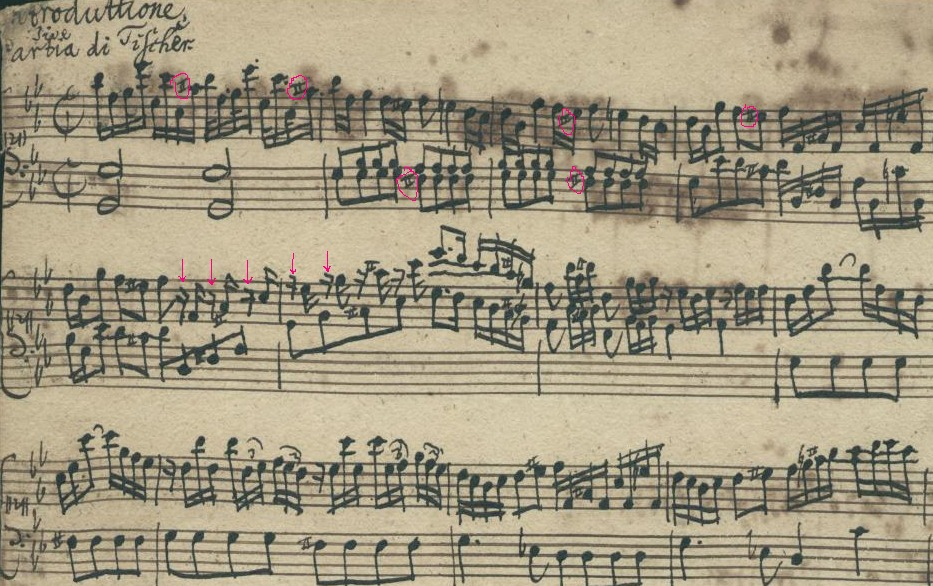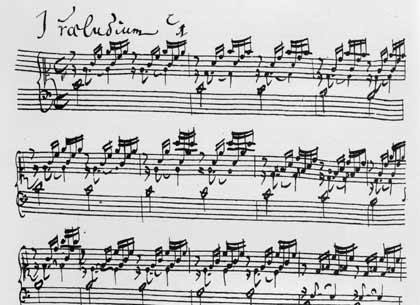No sé mucho de música antigua, pero por la armadura y por la relación de lo que suena con lo que está escrito yo diría que la voz superior no está en clave de sol, sino en clave de do en primera línea. La nota con el sostenido sería entonces Fa#5. Los "sietes" son silencios de semicorchea.

muchas gracias amigo, si alguien mas tiene alguna opinion se agradece, mi otra pregunta es si esos signos que enmarco de primeras, seran sostenidos o no, o seran otra cosa
gracias de nuevo!!!

muchisimas gracias amigos, creo que con estas explicaciones ya podre sacar el resto, da gusto tener compañeros como ustedes en hispasonic al tomarse el tiempo para responder inquietudes como esta.
Todo sea por el Arte, Larga vida al arte y a Hispasonic!!!!!!!!!!!!!
saludes y gracias otravez

Hi Igarido
Thank You for your feedback. In general I do want to be completly clear with my project about what I am doing, that was the reason why I put the slides about the workflow directly on the very first page. And I do still think that the name of my project does not pretend anything wrong about my project nor did I anywhere else.
That is also true for using the word "recording" which is in no way dependent from producing music in the way they did it two hunderd years ago. The proper defintiion of "recording "is an electrical or mechanical inscription and re-creation of sound waves," if we can trust Wikipedia in this aspect and that is exactly what I do when I produce one of the recordings audible on my site.
On the other hand, the main reason of my project is not to argue which way to produce music might be superior to which other. Thats why I do not feel any need to start on every page a discussion about the problems of traditional "playing" around with serious music (which is particularly in respect to the very often musically definitly not that reasonable "mechanical" deficiencies of traditional "playing" very often quite far from being a very convincing way to reproduce musical ideas.)
My thoughts about what is attractive for me in the way I am working are accessible from everywhere via the "Information"-menu and the "about" link. (And even in this page are above the text also some unmistakeable slides showing how I use a DAW to produce my recordings)
The only real reason for my project is the music I love and that I do have very much fun to produce it in the way I do. For me it is a great way to discover music and ways of their interpretation, which are as far as I can see pretty hardly reachable with other means.
At least today there are really very few "traditional" musicians which were able to impress me with what they are doing (there were some in the past but I do not know that much any more today). Thats why I personally can not se any occasion to discuss anything what might really pretend to be in any general meaning "superior" to a serious usage of the currently avaible technical means.
If we would realy start that kind of discussion, I personally honestly fear that many if not most of them who nowadays simply go on to "play" music as if electricity was still not invented, seem to me simply to lazy to update their procedures to the actual stage of development, trying to euphemize their shortcomings with a more or less not very reasonable abstract Idea of authenticity.
But however "chacun a son gout". At least I do have the impression that this is nothing I have to discuss more than I already did in my project.
However thank you once more for your feedback, which was nevertheless quite interesting for me.
best
fahl5






![{] ∞Ω∞ [}™](https://users.soniccdn.com/images/130/67110_cmf0z.jpg)


